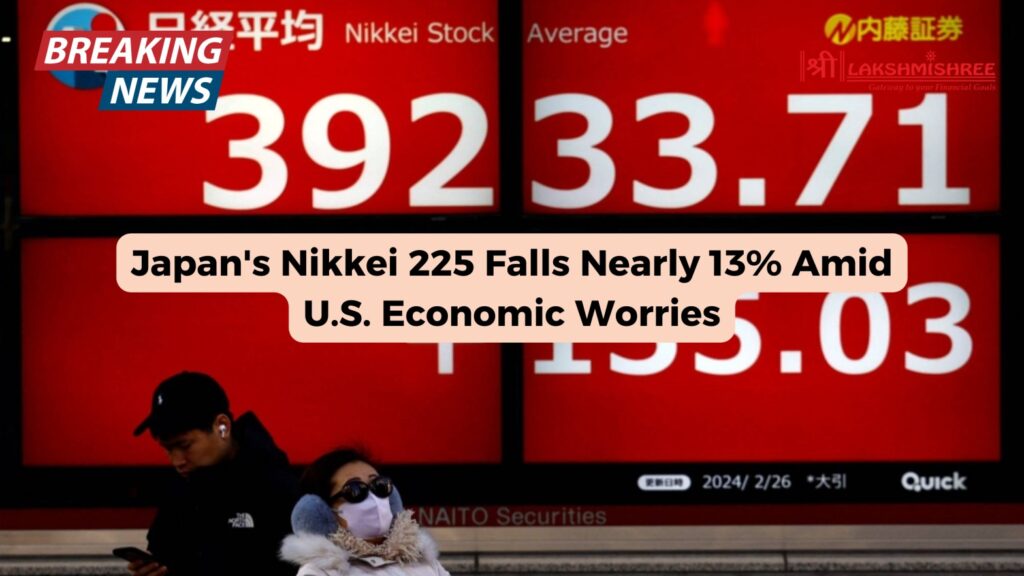Japan’s benchmark Nikkei 225 stock index plummeted nearly 13% on Monday, continuing the dramatic sell-offs that shook global markets last week as worries about the U.S. economy intensified.
Not far from the close in Tokyo, the Nikkei fell over 4,500 points to 31,341.29. The broader TOPIX also plunged sharply, down 11.5 percent as the selling pressure increased in the afternoon.
It was driven down by a report that there’s been a serious slowdown in American hiring last month, which shook financial markets. The losses extended into the close, eliminating all of the recent gains that had powered the Nikkei to fresh all-time highs above 42,000 points.
The Nikkei 225 plunged almost 6% on Friday alone and heads toward the worst two-day decline in history. The biggest single-day drop came on the “Black Monday” of October 1987, as it lost 14.9%. It’s down 4.3% from one year ago now.
The benchmark interest rate of the Bank of Japan, raised last Wednesday in part because of the constant weakness of the Japanese yen, has also been partially responsible for the downturn of the market. How the yen depreciated caused inflation to surge past the target level of 2% by its central bank. Early Monday, the dollar was at 142.67 yen, down from 146.45 yen on Friday and much lower than over 160 yen a few weeks ago.
The turmoil in financial markets is but the most recent of a raft of negative blows to stocks heavily weighted toward sectors heaved down the technology and semiconductor sectors. South Korea’s Kospi index fell 6.5% on Monday, while shares of Samsung Electronics Co., Ltd.—the largest smartphone maker globally—slid 7.7%. Taiwan’s Taiex index dove 7.4%, with shares of Taiwan Semiconductor Manufacturing Co. Ltd., the world’s biggest independent semiconductor foundry, down 8%.
Weaker-than-anticipated data out of the U.S. labor market stoked global market fears about a possible recession. Early on Monday, futures for the S&P 500 and Dow Jones Industrial Average were down 1.5% and 0.7%, respectively.
According to market analyst Stephen Innes, the greater increase in market volatility explains deep-seated anxiety driven by growing fears of another recession. The fear index of investors over potential slides in the S&P 500, as measured by the VIX index, dropped around 26% Monday at the open. Bitcoin tumbled 14% to $54,155.
Despite all the tumult, oil prices remained relatively stable, with the U.S. benchmark crude only fractionally higher to $73.61 per barrel while Brent crude was flat at $76.81 per barrel.
The investors now eye the Institute for Supply Management’s upcoming U.S. services sector data to see whether recent global market reactions were justified.
In Asia, Hong Kong’s Hang Seng index fell 0.2%, and Australia’s S&P/ASX 200 slid 12.8%. The Shanghai Composite index, which is partially insulated from global markets as a result of capital controls, rose 0.1%. The S&P 500’s decline of 1.8% on Friday represented the index’s first back-to-back losses of more than 1% since April, while the Nasdaq composite depressed by 2.4%. The Federal Reserve could be maintaining interest rates at an uncomfortable high level for a longer period nominated, and obviously, this adds heaps to the concerns over a recession, even when investors earlier had been expecting cuts as per cues from Fed Chair Jerome Powell back in September. The market fears the risks that higher unemployment may trigger lower spending, hiring, and general economic activity, which would drive the world’s biggest economy into a second recession, said Tan Boon Heng at Mizuho Bank in Singapore.
Do you have a news tip for Lakshmishree reporters? Please email us at media@lakshmishree.com
Source: Moneycontrol

News Desk



